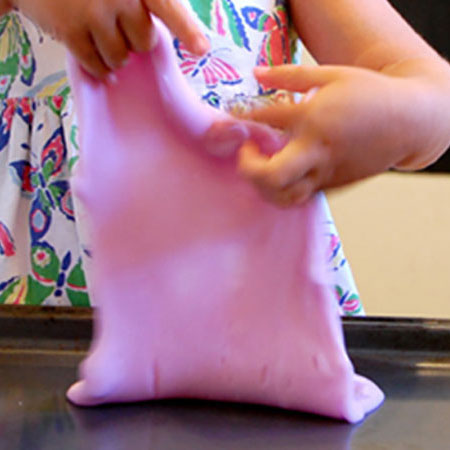 Image from PBS Kids for Parents.
Image from PBS Kids for Parents.
Smooshy Slime
- Advanced
- Very Messy
- 60 Minutes
- Indoor
Smooshy Slime
Who doesn’t love slime? Slime is oobleck’s ooey-gooey cousin, and another example of a non-Newtonian fluid. When all of the ingredients in this activity are combined you get a squishy substance that is fun to stretch, shape, and smoosh. Try it!
You Will Need
1 large plastic or glass bowl
1 small plastic or glass bowl
¼ cup school glue (any kind of school glue will work)
2 cups warm water (not too hot)
Food coloring (optional)
1 teaspoon of Borax (a type of powdered soap you can purchase at the grocery store)
Directions
- Squeeze about ¼ cup of glue into the larger bowl.
- Mix in about ¼ cup of warm water.
- Add your food coloring, if desired. You can add as many drops as you want to achieve the color you want.
- In your smaller bowl, mix 1 teaspoon of Borax into a ½ cup of water.
- Slowly add the Borax solution to the glue mixture. Only add in Borax until the slime starts to stick together. You might not have to use all of the Borax solution.
- Knead the slime. At first, it will be really wet and gooey, then stringy and sloppy. After about 10 minutes it will hold together in one easy to work with mass of slime.
- When you are done playing with your slime you can refrigerate it in an airtight container for about two weeks. (After two weeks it may start to smell!).
Experiment Extensions
- Vinegar will dissolve slime! Try dropping a piece of your slime into a cup of vinegar and observe what happens. This is another chemical reaction!
How it works
So how does slime form? You need two things: polyvinyl alcohol (the main ingredient in washable school glue) and borate ion (which you get from the Borax).
When these two ingredients are introduced to one another, a chemical reaction happens where the polyvinyl alcohol is attracted to the borate ion. This attraction makes the two molecules form long chains, called polymers. Many, many polymer chains group together to form the slime we love!
Slime is called a non-Newtonian fluid, which means its viscosity, or thickness, can be changed by squeezing, stirring, and adding pressure.
Most fluids, such as milk or water, change viscosity by heating or cooling (think about what happens when you add heat to water, or when you cool it down!).
Key Words
- Chemical reaction
- A change that occurs when two or more substances combine to form a new substance
- Molecule
- The smallest unit of a substance that has all the properties of that substance. For example, a water molecule is the smallest unit that can still be considered water.
- Non-Newtonian Fluid
- A fluid in which the viscosity changes when force is applied as opposed to heat or cold
- Polymer
- Large molecules made of small, repeating molecules
- Viscosity
- The property of a liquid that describes how fast or slow it will flow
